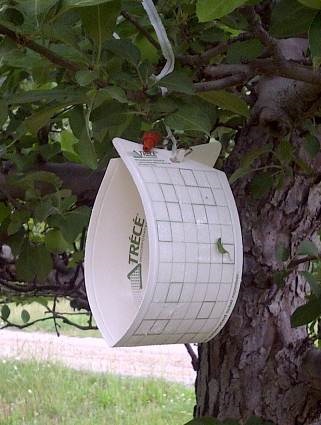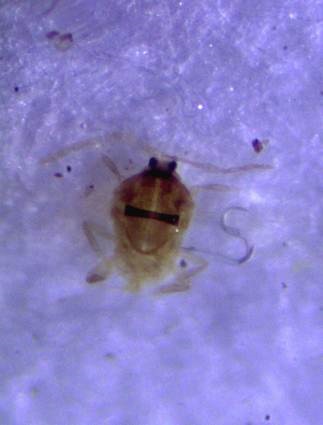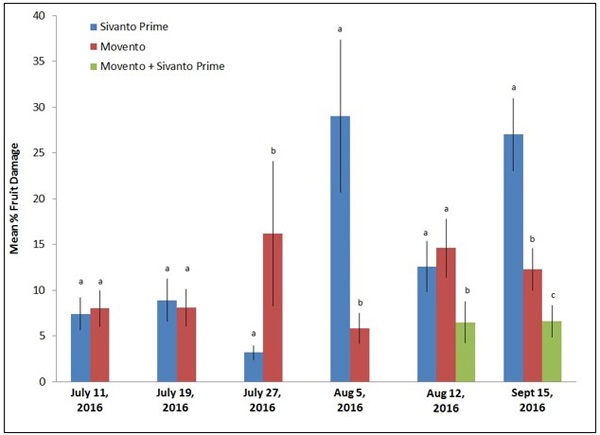Predicting San Jose scale crawler emergence in Ontario apple orchards
Learn management strategies and how to identify San Jose scale crawler.
Despite being native to Ontario, fruit damage by San Jose scale (SJS), Quadraspidiotus periciosus (Comstock) in apple orchards was minimal in the past. The increase in populations in orchards over recent years is likely a result of changes in the products used in our IPM program (e.g. reduced use and loss of broad-spectrum fungicides).
A better understanding of both insect activity and development is required to optimize the use of newer, reduced-risk products. Due to the lack of monitoring techniques and forecasting models tested in Ontario, appropriate timing for summer control strategies for SJS is unknown. Preliminary Ontario trials using US-based degree-day (DD) models have resulted in varied predictions. Two orchards were monitored in 2016 to evaluate the potential of a more precise Ontario DD model.
Method
Two apple orchards with a historically high SJS pressure were selected for this project. Monitoring began at pink on Ambrosia (Orchard 1) and Empire/McIntosh (Orchard 2) varieties. Throughout the orchards, 10–15 trees with high incidence of overwintering scale were flagged. These trees were used to monitor insect activity for the duration of the project.
Predicted crawler emergence from two DD models (Table 1) were compared to observed crawler emergence. Temperature data was collected daily from on-site data loggers. Two pheromone traps (Figure 1) were installed at king bloom in each orchard and checked weekly to determine adult flight (Figure 2). Electrical tape (sticky side out) was wrapped around limbs of 5 infested trees at petal fall to detect crawler activity (Figure 3). Each trap was monitoring 1–2 times weekly and replaced when the tape was no longer sticky to the touch.
| Model | Biofix | Base T (°C) | Crawler Emergence 1st Generation | Crawler Emergence 2nd Generation |
|---|---|---|---|---|
| A | March 1st | 10 | 278 DD | 806 DD |
| B | 1st adult catch | 10.5 | 222–249 DD | N/A |
Beginning at petal fall, scouting for crawler emergence was also conducted on a weekly basis on all flagged trees. Observations of overwintering female scale determined the presence of crawlers under the scale shell. As well, infested branches and developing fruitlets were monitored using a hand lens for the presence of the small, yellow insect. Monitoring continued until harvest.
On June 4, newly registered Sivanto Prime (flupyradifurone) at 1 L/ha and Movento (spirotetramat) at 365 mL/ha were applied for 1st generation SJS control in Orchard 1. Both treatments were re-applied on June 22. Sivanto Prime at 1 L/ha was also applied to a portion of the Movento block on August 9, targeting 2nd generation emergence and re-applied on August 23. Weekly fruit assessments were conducted on 250 fruit per treatment for incidence of SJS damage.
Results
Table 2 summarizes the crawler emergence predicted and observed in both orchards. Overall, both models were very accurate in predicting 1st generation SJS crawler emergence. Electrical tape was installed a week later than anticipated in Orchard 1 due to re-entry restrictions. Crawlers were trapped immediately indicating emergence likely began the week prior. The 2nd generation crawler emergence predicted by Model A also corresponded to what was observed in both orchards.
Based on DD accumulation using first adult catch biofix, 2nd generation crawler activity began around 720–780 DD in both orchards. Monitoring will continue in the upcoming seasons to confirm and/or fine-tune this estimate.
| Model | Biofix | 1st gen. SJS crawler emergence Predicted | 1st gen. SJS crawler emergence Observed | 2nd gen. SJS crawler emergence Predicted | 2nd gen. SJS crawler emergence Observed |
|---|---|---|---|---|---|
| Orchard 1 - A | March 1< | June 13–14 | June 20 | July 30–31 | July 27 |
| Orchard 1 - B | May 15 | June 10–14 | June 20 | Not established | July 27 |
| Orchard 2 - A | March 1 | June 20 | June 22 | July 27–28 | July 27 |
| Orchard 2 - B | May 12 | June 22–26 | June 22 | Not established | July 27 |
Movento provided longer lasting control of SJS compared to Sivanto Prime (Fig. 4) in Orchard 1 when applied for 1st generation SJS crawlers. However, Sivanto was applied 1–2 weeks earlier than the predicted timing for this product which likely resulted in less residual activity at the time of crawler emergence. Since Movento is slow-acting and generally takes 1–2 weeks before activity, an earlier application timing than that predicted is acceptable. Movento for 1st generation SJS crawler emergence followed by Sivanto for the 2nd generation significantly reduced damage by the end of the season. While early season control will reduce pressure in subsequent generations, orchards with high SJS pressure will benefit from a season-long program.
Successful SJS control starts with prevention. The following are some key points to consider for effective management:
- Map out localized scale pressure and use harvest assessments to verify. Target sprays to those hot spot areas in the orchard.
- Once established, SJS can be very difficult to eradicate. Use a targeted SJS control program season-long for several years to achieve effective management.
- Prune to remove infested branches, open canopy and allow better spray penetration.
- Dormant oil can be very effective by targeting immature scales before they develop a protective waxy layer. However, complete coverage and timing are essential. Details on dormant oil sprays for scale and mites can be found in the February issue of Orchard Network (Volume 17 Issue 1).
- Use a DD model with biofix of March 1st (base 10°C) or first adult catch (base 10.5°C) along with scouting to accurately time control products targeting crawler emergence.
- Using a set calendar date biofix such as March 1st does not always reflect actual insect development in an individual orchard compared to observed flight. In Ontario, predictions have tended to be approximately 1 week earlier than observed crawler emergence using this model.
- Adult SJS can be difficult to detect on a pheromone trap without the use of a hand lens, due to size. As well, in lower pressure sites, trap catch may be inconsistent.
- Trapping using electrical tape can be labour intensive to install and must be replaced frequently due to excess debris, spray and/or insects depending on placement in tree.
- A hand lens is also required for monitoring of crawlers due to small size. Flag trees infested with overwintering SJS during harvest assessments at the end of the year or before the canopy fills in early season. Focus monitoring for crawlers during the summer on those trees while still observing general fruit damage throughout the block.
Special thanks to the cooperating growers for allowing the use of their orchard. Technical assistance by Erica Sayles and Chris Burnie. Funding provided by Horticulture Crops Ontario and product donation by Bayer CropScience.
Footnotes
- footnote[1] Back to paragraph First crawler emergence corresponds to ca. 29±12.5 days McIntosh petal fall.
- footnote[2] Back to paragraph Second crawler emergence corresponds to ca. mid-July.
- footnote[3] Back to paragraph First adult catch corresponds to ca. 1st generation codling moth biofix.
- footnote[4] Back to paragraph Emergence trap installed week later than anticipated. Immediate trap catch indicates crawler activity began week prior.
- footnote[5] Back to paragraph Based on first adult male SJS catch.



